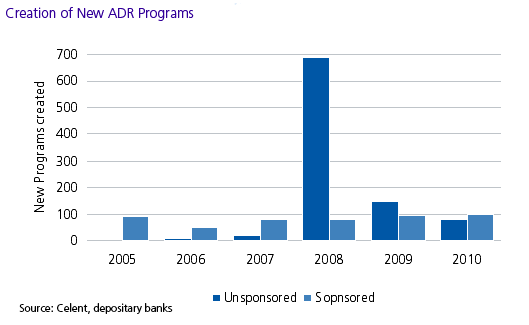American Depositary Receipt: Market Trends and the Role of Regulation
Abstract
Investment in foreign equities by US investors has been growing at more than 10% in recent years and reached US$3.9 trillion in 2010, 19% of total equity holdings. Higher returns and diversification are the main factors driving international investment. ADRs are different from the other instruments in certain ways and have often produced returns superior to domestic equities, making them a popular choice for investors.
Investing in international markets has gained prominence over the last two decades. There are two main reasons for US investors to invest in foreign companies: increasing return and diversifying. Investors choose ADR over other modes of foreign investment instruments for a number of reasons. Not many foreign firms list on US exchanges. International mutual funds and ETFs track broad portfolios of countries or sectors, while one can invest directly in individual companies through ADRs. Also, mutual funds and ETFs charge management fees.
Investing directly in a foreign country is difficult due to information flow, regulatory hurdles, currency risk exposure, time zone mismatches, etc. Many of these issues can be overcome by investing in ADRs. Investing in foreign equities in general, and ADRs in particular, is a high-risk high-return proposition. It has been observed that during risk adjusted returns of 2003-2009 ADR indices returns beat the S&P 500 every year except 2008. Moreover, ADRs from every region outperformed the S&P 500 almost every year during the same period with emerging regions significantly outperforming S&P 500. The ADR market is dominated by institutional investors (accounting for 72% of total holdings) because they are better able to access, acquire, and process all the relevant information involved in trading in foreign companies.
There are currently over 2,200 ADR programs; almost half of them (about 48%) are unsponsored programs, while the rest are sponsored. A rule change made by SEC in 2008 allowing depositary banks to start unsponsored programs without necessarily taking consent of the underlying company has had a sig- nificant impact in the ADR market. Immediately after that there was an explosion of new unsponsored programs. Many instances were found where foreign firms were cross-listed involuntarily after the new regulation was enacted. Consequently many companies are issuing disclaimers on their websites that they are not responsible for any unsponsored ADR program that they are involved in. This can create doubts in the minds of investors. Hence, some companies are converting their unsponsored ADR programs to sponsored level I program to exercise greater control over their own shares.

In light of this, choice of new ADR programs is likely to become more prudent and rigorous in the future. In the short to medium term, creation of new unsponsored programs is likely to slow down. This is because of a post-2008 rule change. All the unsponsored programs that could be of investor interest, have already been created. Consequently the unsponsored market ADR marketplace has become saturated. Moreover, some firms with unsponsored programs are likely to convert to sponsored programs to attain greater control over their shares.
Listing of some unsponsored programs as well as cross-allocation of ADR programs among different levels is another phenomenon that is likely to take place. “As a result creation of new unsponsored programs is expected to slow down, delisting and reallocation of ADR programs are likely to pick up. This implies the market will become more ‘mature’ because only serious players, issuers as well as investors, will take active roles in future developments, and the market is likely to remain concentrated,” says Arin Ray, Analyst with Celent and author of the report.”International ETFs are fast gaining popularity among the investors. This may be a barrier to growth of the ADR market. Therefore, product innovation is expected to become a niche yet significant phenomenon shaping this market.”
In a new report, American Depositary Receipt: Market Trends and the Role of Regulation, Celent studies the ADR market. The report analyzes the trends in international investing by the US investors and compare the evolution of different modes of foreign investments. It looks at the ADR market and discusses the merits of investing in ADRs. We discuss trading and capital-raising activities through ADRs. The report also examines the key issues affecting market participants, namely the issuers, investors, and depositary banks, as well as regulatory issues. We conclude with Celent’s take on the existing ADR market and our expectations about future developments.

